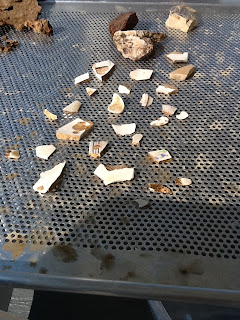Yet again, a new study seems to have found evidence of the interbreeding of ancient human populations.
Friday, July 27, 2012
Saturday, July 14, 2012
Early Immigrants and the Politics of Archaeology
For the past century, one of the most fascinating questions in archaeology, especially American archaeology, has been that surrounding the first human migrations into North and South America. For most of the last half of the 20th Century, most archaeologists agreed that the first settlement happened around 12,000 years ago and that the first residents were the Clovis culture, distinctive by their fluted spear points. During the past 30 years, however, that model has come under sustained attack by new data. The archaeological consensus has now shifted to an earlier occupation of the hemisphere and that the Clovis people were not first and not alone.
Thursday, July 12, 2012
The Catalog is Done, Dude...
Joe and I completed the initial catalog of artifacts today. About 1166 recovered in our four weeks on site. There's still a lot of research and writing to do, but I hadn't expected to find the diversity or abundance of artifacts prior to the field season. I still feel we're looking at a late 19th Century occupation, but the specific nature of the activities at the site are still not clear...though they were smoking.
Here's a few more shots of the artifacts...many more details to come.
Here's a few more shots of the artifacts...many more details to come.
Wednesday, July 11, 2012
Toddlers, Tarsiers and Teeth
I just returned from taking my two small sons to the dentist. By the way, if I had known the costs of something like dentistry before having kids...I don't know if they'd be here now.
This visit marked the first time my four year old had x-rays taken. When we viewed the images, I was struck by how much his mandibular incisors (bottom front teeth) looked like that of a prosimian dental comb. Primates are noted for their lack of dental specialization (to take advantage of varied and flexible food sources), but the dental comb is a classic example of some specialized dentition that does occur in non-human primates.
Despite the adaptive specialization found in dental combs, I still found the common ancestry apparent. My son and a lemur may look very different now, but that x-ray reminded me in a visceral way how they do share grandparents from about 50 million years ago.
This visit marked the first time my four year old had x-rays taken. When we viewed the images, I was struck by how much his mandibular incisors (bottom front teeth) looked like that of a prosimian dental comb. Primates are noted for their lack of dental specialization (to take advantage of varied and flexible food sources), but the dental comb is a classic example of some specialized dentition that does occur in non-human primates.
Despite the adaptive specialization found in dental combs, I still found the common ancestry apparent. My son and a lemur may look very different now, but that x-ray reminded me in a visceral way how they do share grandparents from about 50 million years ago.
 |
| My oldest son |
| Human Mandibular Incisors, not my son (disregard B and C) |
| Lemur Dental Comb (also mandibular incisors, plus modified canines) |
| Not my son |
Monday, July 9, 2012
Almost Famous
We made the local paper. I'll just add that I think our gear in the background of the photo looks like a mess and I really wish we had some crew who would have kept it organized.
http://www.recordonline.com/apps/pbcs.dll/article?AID=/20120709/NEWS/207090328
http://www.recordonline.com/apps/pbcs.dll/article?AID=/20120709/NEWS/207090328
Thursday, July 5, 2012
Engage Cataloging
Maybe it's the day alone in my office with nothing but artifacts and I feel I must seek out some human connection...so here's another post. As noted earlier (yes, today), all artifacts recovered from the 2012 season have been washed. This afternoon, I began the cataloging process and have gotten through 133 individual artifacts (and there's many more to do, my guess is that I got through about 10% today).
I've included some quick pictures, including of a pipe bowl fragment that seems to have an eagle wing and neck design on it.

I've included some quick pictures, including of a pipe bowl fragment that seems to have an eagle wing and neck design on it.

 |
| Pipe Bowl Fragment (you can't really see the design in this image) |
Final Clean Up

The transition out of the field is almost complete. Today, I hope to finish the last of the basic washing of the remaining artifacts we recovered. Here's an exciting shot of sherds (yes, that is how you spell it) and sundry rocks (likely nothing) drying in the bright July sun on the porch of the Christine Morrison House (side note: my department recently moved buildings on campus and as far as space goes, we've experienced a significant downgrade. However, the porch is a nice consolation prize).
 |
| Science!!! |
Subscribe to:
Comments (Atom)






